When it comes to tackling a DIY deck-building project, the task may appear far more intricate than it initially seems. There are many parts to a deck, and understanding how they all come together requires in-depth knowledge and experience.
For this reason, it’s often more efficient and safer to hire a professional, ensuring your deck is constructed to last and remain secure for years to come.
Yet, even when employing a pro, it’s still crucial for homeowners to understand the different parts of a deck. This knowledge allows you to oversee the project effectively, communicate your ideas clearly, and ensure the final result aligns with your vision.
In the following guide, we’ll break down the various components of a deck to give you a clearer understanding of what goes into building your ideal outdoor space.
Table of Contents
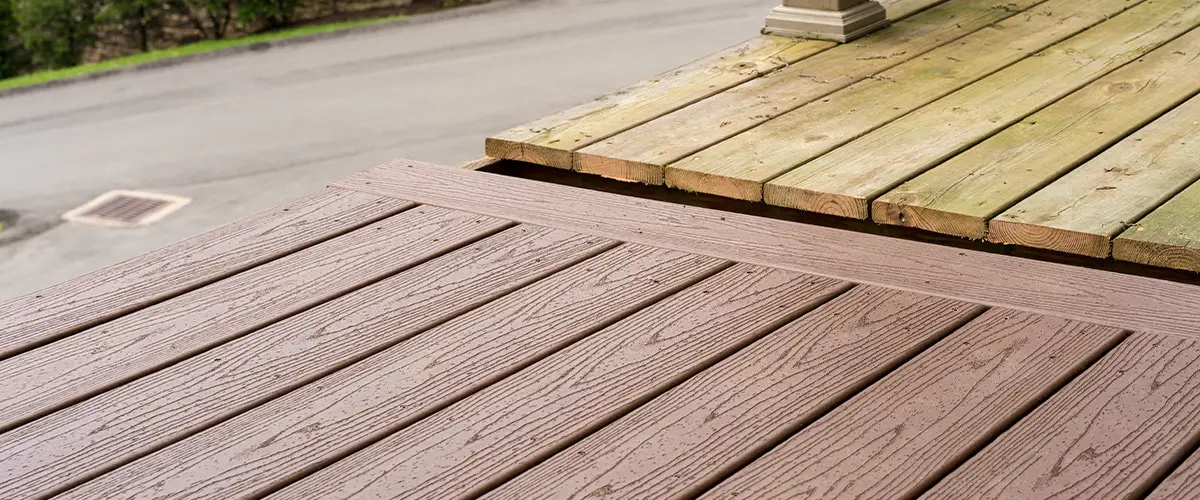
Key Takeaways
- Decks have two main parts: the foundation and the structure. The foundation includes footings, piers, and concrete blocks that support your deck.
- The structure is what's visible. It has several components, including ledger boards, support posts, beams, joists, and rim joists that make it strong.
- Deck surfaces are made up of decking boards held in place by hidden fasteners. Fascia boards add a neat finish to your deck.
- Safety features like railings and balusters protect you from falling off the edge of your deck.
Deck Foundation
The deck foundation is a critical element of any deck structure, primarily consisting of footings, piers, and concrete blocks. Footings provide the base support for your deck, dug below the frost line to prevent movement during ground freezes.
Piers or posts are vertically embedded in the ground and rest on top of the footings for added support. Concrete blocks offer additional stability and structural integrity while evenly dispersing weight across the surface.
Proper installation at this stage ensures long-lasting durability and safety of your outdoor living space.
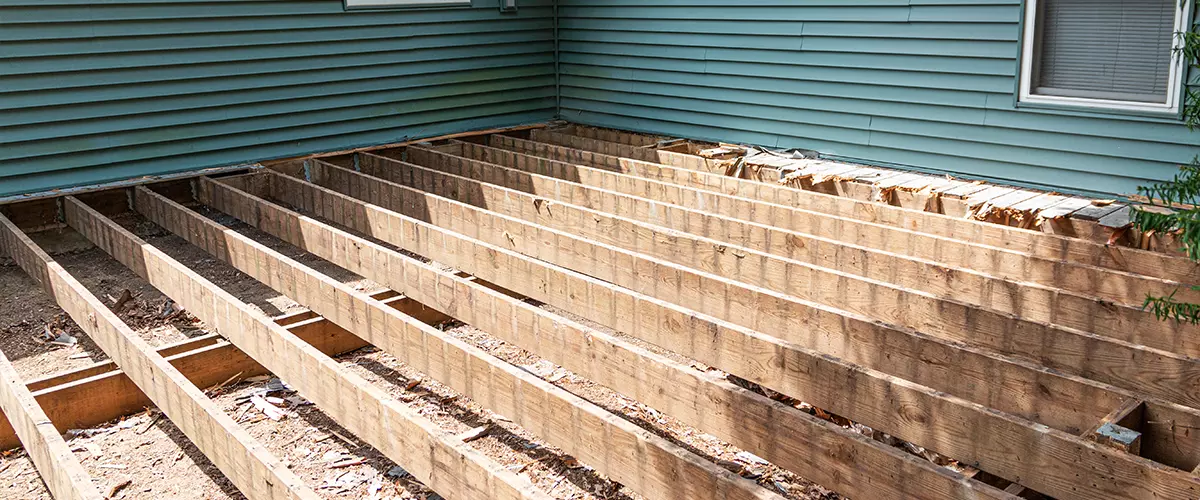
Footings
Footings play a vital role in the construction of your deck by providing a solid foundation. They bear the weight of your deck, helping to distribute that load evenly across the ground beneath.
Typical footings are made from concrete and set below the frost line — the depth at which groundwater freezes in winter — to prevent shifting during freeze-thaw cycles. Different types of footings suit different soil conditions and decks sizes, so it’s important to choose wisely for secure installation that meets local building codes.
Properly installed footings enhance your deck’s structural integrity while also extending its lifespan.
Piers
Piers provide critical support to your deck’s structure. They act as strong pillars, ensuring the stability and durability of your outdoor living space.
Composed typically of concrete, piers are placed in the ground beneath your deck for a solid foundation.
The size and spacing of these components depend on local building codes and the overall size of your deck project.
Deck piers bear the weight of your entire deck surface, transferring it evenly to the ground. When installed properly with secure fasteners, they deliver structural integrity to withstand heavy loads and resist movements due to changes in weather or ground conditions.
A substantial part of any robust decking installation is making sure each pier is level and aligned accurately within its footing circle or square hole before pouring concrete into it.
Concrete Blocks
Concrete blocks play a critical role in the construction of a deck as they form part of the foundation. They offer substantial support to the deck’s structure by being set directly on top of concrete footings, providing additional strength and stability.
Each block carries a portion of the weight from your outdoor living space, ensuring that heavy loads are evenly distributed over a larger surface area. Concrete blocks ensure structural integrity, resist ground freezes at frost line levels, and adhere to local building codes for secure installation.
It is essential to use high-quality concrete blocks and position them correctly for an effective and durable deck substructure.
Deck Structure
The deck structure is the backbone of your outdoor living space, providing a solid and secure foundation. The ledger board, typically attached to your house, provides crucial structural support.
Support posts anchored in concrete footings hold up the overall structure while bearing the weight it carries. Beams intersect with these posts and offer horizontal support for the deck floor or surface.
Joists run horizontally along the top of beams to form a sturdy framework underneath your deck boards. A rim joist forms part of this network by enclosing the outer perimeter of your deck’s frame, offering both support and aesthetics.
Lastly, blocking or bridging ensures that interior joists stay straight over time, enhancing stability and structural integrity – they’re essential, especially for larger decks where added strength is required.
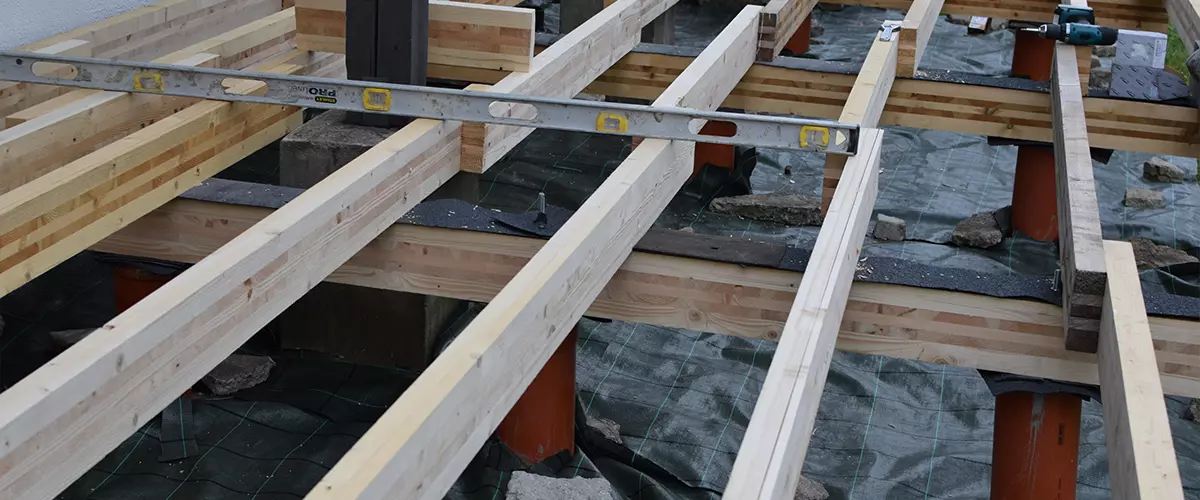
Ledger Board
The ledger board holds a significant role in the overall structure of a deck. It’s typically attached directly to your house and provides substantial support for all interior joists.
To maintain structural integrity, the ledger board should be securely fastened with proper fasteners such as large bolts or screws. Additionally, it’s crucial that decking materials like treated lumber are used for this component to ensure durability and longevity against weather conditions and potential decay.
The right installation includes attaching it at the correct height according to local building codes and ensuring it aligns perfectly with your deck project design, whether you choose traditional wood or composite material types.
From deck patterns to spacing between grooved boards, every detail counts when working with a ledger board – considering its vital role in providing structural support for your outdoor living space.
Support Posts
Support posts play a critical role in the deck structure. They provide essential support to your deck surface by transferring load from the beams down to the footings and piers, ensuring structural integrity and safety of your outdoor living space.
Using properly treated lumber or metal for these components is important as they resist decay and weather damage. Secure installation methods, such as post anchors, make certain that your deck stays upright under force.
Larger decks may require additional support posts for added stability. Be sure to check local building codes for spacing requirements between support posts on your deck project.
Beams
Beams play a crucial role in the construction of your deck. They are horizontal structures that sit on top of the support posts, providing essential structural integrity as they distribute weight evenly across all areas of your deck.
These robust components often consist of two pieces of lumber, securely fastened together for optimal strength and stability. Complying with local building codes, ensuring beams are correctly spaced and installed is vital to avoid an uneven deck surface or shaky framework underneath.
The distance between beams depends upon the size and layout of the deck but ensuring proper installation equates to secure outdoor living space for homeowners to enjoy without worrying about structural concerns.
Joists
Joists are key elements in your deck structure, providing crucial support for the decking boards that comprise the floor of your outdoor living space. These horizontal structures span the distance between beams and ledger board, creating a framework underneath your deck surface.
Proper installation involves securing them with quality joist hangers or metal brackets to ensure robust structural integrity. Each joist needs to align perfectly, typically attached at equal intervals across the beam and ledger board for an evenly distributed load bearing capacity.
Whether built from traditional wood or composite materials, choosing high-strength deck joists will boost your overall structure’s durability and longevity.
Rim Joist
The rim joist, also known as the outer joist or band board, is a crucial part of your deck. It serves to enclose and stabilize the structure by wrapping around its perimeter. Securing it properly with the right fasteners enhances your deck’s stability and overall integrity.
As an element running along the outer edge of the framework underneath, this structural support integrates with other substructure deck components like joists and beams. It intersects with all interior joists within the horizontal structure – providing uniformity in strength across your outdoor living space.
Blocking/Bridging
Blocking or bridging acts as a crucial component in deck construction, providing extra support to the structure. It refers to installing short pieces of lumber between joists that help prevent them from twisting and warping over time.
This lends strength, stability, and longevity to your outdoor living space.
Deck builders place blocks at midpoints along lengthy joists for added rigidity; these are often mandatory according to local building codes. Besides structural integrity, blocking also offers a practical solution for running utilities like gas lines or electrical conduits beneath your deck without interrupting the overall structure.
Without robust blocking, even premium decking materials can fail to stand up against external pressures.
Deck Surface
The deck surface is more than just the visible part you walk on; it includes the decking, hidden fasteners, and fascia that together provide a sturdy yet appealing outdoor living space.
Discover how each contributes to your deck’s performance and aesthetics in our comprehensive guide.
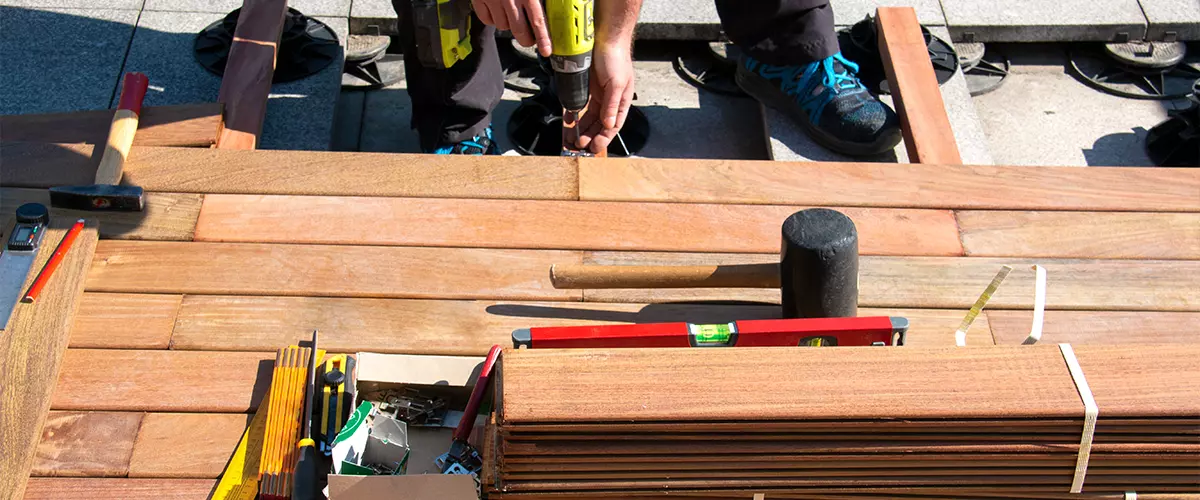
Decking
Decking forms the main surface of your deck. It’s where all activities unfold, so it has to withstand weight, weather, and constant use. Composite materials or traditional wood are popular choices for decking due to their durability and aesthetics.
While composite decks require less maintenance and offer a wider variety of colors, woods like cedar or pressure-treated lumber provide natural beauty.
The process of decking installation involves attaching deck boards perpendicular to the joists via special hidden fasteners or screws on top. Grooved boards often work best with hidden fasteners as they ensure a clean finish without any visible nail heads.
Different patterns can be created by alternating the orientation of these boards, making your outdoor living space more visually appealing.
Hidden Fasteners
Hidden fasteners provide a clean, smooth surface for your deck. They hold the decking boards securely in place without any visible screws or nails on top. This not only enhances the aesthetic appeal of your deck but also reduces tripping hazards.
You install them between the boards, where they remain unseen, hence their name “hidden”. Made from durable materials like stainless steel or coated metal, these fasteners resist corrosion and offer excellent longevity.
They come in various designs to fit different types of decking materials such as wood or composite planks. Some systems even allow for expansion and contraction caused by changing weather conditions, preserving the structural integrity of the deck over time.
Fascia
Fascia boards feature prominently in any deck design as they provide both function and aesthetic appeal. They are the long, straight boards that run along the edge of your deck, hiding its underlying structure and creating a neat, finished appearance.
Secured to the rim joists, fascia acts as a barrier to protect wooden components from weather damages like rainwater or snow.
Choosing the right material for your fascia is crucial. Most homeowners opt for pressure-treated lumber known for its durability and cost-effectiveness. Others might prefer composite materials that require less maintenance but come at a higher price point.
Regardless of your choice, proper installation ensures this critical part enhances your outdoor living space while adding structural strength to your deck.
Deck Safety Features
Ensuring your deck is safe is crucial for peace of mind and the longevity of your outdoor living space. Railings, made from sturdy materials like traditional wood or composite materials, serve as a protective barrier on the edges of your deck.
Balusters support the top rail, providing further protection against accidental falls. Rail posts are securely fastened to ensure that they provide structural support to the railing system.
Your deck stair design includes various components – Stringers act as a backbone for stairs, along with treads serving as stepping surfaces and risers linking each step in straight stairs.
Lastly, an efficient drainage system prevents water damage by channeling away rainwater from your outdoor deck structure, ensuring overall structural integrity and safety.
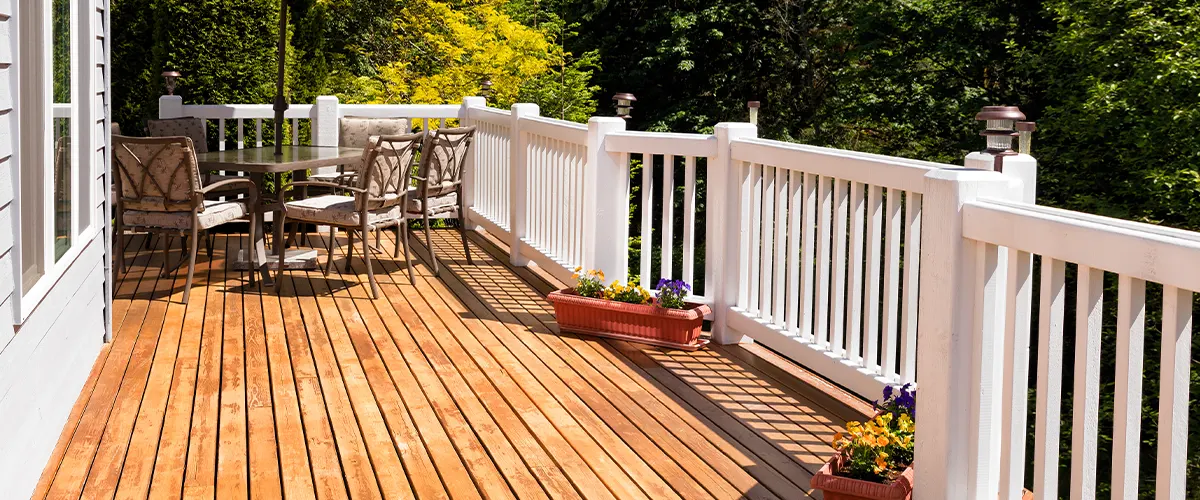
Railing
Deck railings serve a crucial role in ensuring the safety of your outdoor living space. They are typically attached to the deck’s outer perimeter and stair edges, providing protection from falling off.
Local building codes set their height to ensure secure installation for user safety.
The railing system comprises top and bottom rails, balusters, and rail posts, which collectively provide strength to the overall structure. The top rail is supported by wood posts or decorative composite post sleeves, while the bottom rail is securely fastened between these posts.
Apart from security features, modern railing systems also enhance aesthetics with designs often matching decking materials like traditional wood or composite materials.
Balusters
Balusters play a crucial role in the safety and aesthetics of your deck. Often crafted from wood, metal, or composite materials, these vertical pieces connect the bottom rail to the top rail of your deck railing system.
Thoughtfully chosen balusters can enhance an outdoor living space’s design theme while keeping everyone safe by preventing accidental falls over the edge. Their installation must comply with local building codes that dictate specific spacing and height requirements, ensuring a secure installation for worry-free enjoyment of your deck area.
Rail Posts
Rail posts provide crucial support and stability to your deck railing system. They are typically made of durable materials like metal or treated lumber, designed to withstand weather elements.
Installing these posts securely is essential for the integrity of your entire outdoor living space.
Securing rail posts can vary depending on decking materials and local building codes. However, they are generally attached at key points around the outer perimeter of the deck frame for maximum strength.
Some homeowners choose decorative composite post sleeves to add style while maintaining safety standards.
Stairs
Deck stairs provide vital access to your outdoor living space. Constructed from durable materials, they are generally made up of stringers, treads, and risers. Stringers support the structure while treads form the flat stepping surface you walk on.
Risers fill in the gap between each step for a smooth appearance and added safety features. Depending on your deck height and local building codes, the design can range from straight stairs to more complex patterns for larger decks.
A secure installation process ensures lasting stability so you can enjoy worry-free movement around your outdoor deck area.
Stringers
Deck stairs are incomplete without stringers, which hold the essential role of supporting the steps. These are longboards that slope along the sequence of your stair treads and risers, providing structural support to avoid accidents.
Stringers ensure that you can climb up or down your deck stairs safely and comfortably. They come in different materials, such as traditional wood or composite materials, to match your deck design preference.
Always consider local building codes for proper installation and secure fastening of stringers to maintain both the safety and structural integrity of your outdoor living space.
Treads
Treads make up the horizontal part of your deck’s stairs where you set your foot. They’re built from sturdy materials like wood or composite to withstand heavy traffic and weather conditions.
Without solid, well-installed treads, climbing up and down your outdoor deck can be a risky affair as they provide the grip needed to prevent slips and falls. Treads aren’t just functional; they also add aesthetic appeal to your deck stair design.
Choose the right design that complements the overall style of your deck for an appealing outdoor living space.
Risers
Risers play a crucial role in deck stair construction, enhancing both safety and aesthetics. They are the vertical sections that fill in the space between each step, adding stability to your stairs while preventing accidental slips from underfoot.
Crafted from durable materials like treated lumber or composite materials, risers can withstand varying weather conditions and heavy foot traffic.
Installing risers correctly ensures their longevity and effectiveness. It’s important to adhere to local building codes for dimensions and requirements during installation. Securely fastening them with proper fasteners not only maintains structural integrity but also contributes significantly to the overall deck appearance.
Paired with matching treads, risers can make your outdoor deck stairs visually appealing as well as functionally safe.
Drainage System
Good deck construction includes a drainage system that prevents water from pooling under the deck. This essential feature channels water away from your home, preserving its foundation and reducing potential damage.
A well-installed drainage system also protects your decking materials against rot and decay, thus prolonging the life of your outdoor space. It typically consists of troughs or flanges installed between each joist beneath the decking surface itself, effectively collecting and diverting rainwater runoff from around and underneath the deck.
The effective use of downspouts and gutters ensures this water is then directed to an appropriate discharge point.
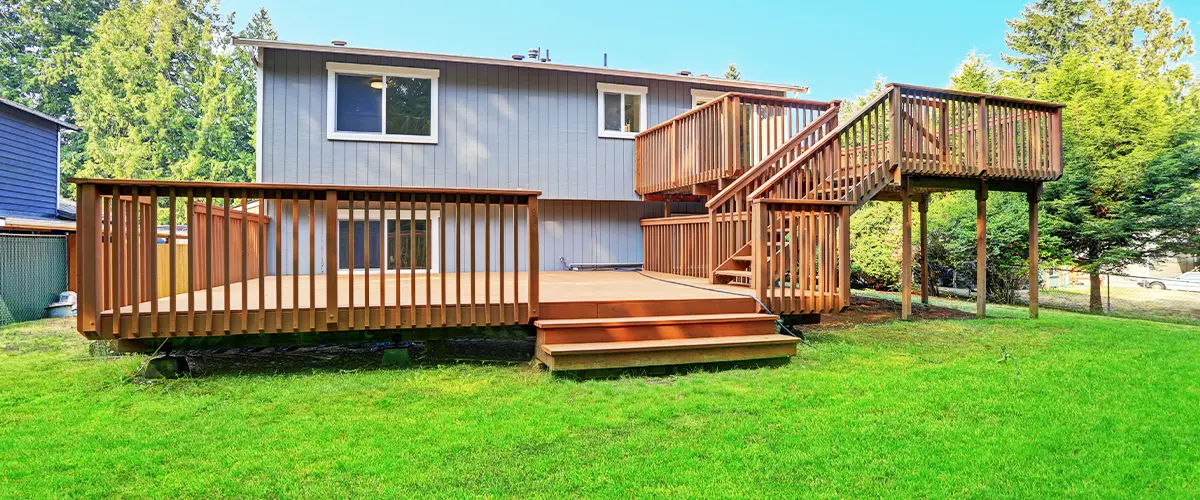
Parts Of A Deck FAQs
A deck is primarily made up of the deck platform, railings, balusters, and stairs. The platform, built from joists and beams, forms the foundation.
Railings, composed of top and bottom rails, balusters, and rail posts, provide safety and aesthetics.
Stairs, consisting of stringers, treads, and risers, ensure easy access to the deck. A drainage system is also important to prevent water damage.
Deck structure begins with setting the footings, which provide a stable base. Next, the installation of the ledger board attaches the deck to the house. This is followed by framing the deck with joists and beams to create the platform.
Decking boards are then fastened onto the frame, creating the surface of the deck. Railings, balusters, and rail posts are added for safety and aesthetics. Finally, deck stairs are constructed using stringers, treads, and risers.
A drainage system is incorporated to prevent water damage. The entire process must adhere to local building codes to ensure safety.
The top part of a deck is known as the “decking.” This is the flat surface that forms the “floor” of the deck, where people walk, sit, and place furniture.
Decking is attached to the underlying frame (made of joists and beams) and can be made from a variety of materials, including wood, composite, or PVC. It’s essential that the decking is installed correctly and maintained regularly to ensure longevity and safety.
A deck is a type of outdoor platform structure. It’s often attached to a house, though it can also be free-standing. Essentially, it’s a raised floor, usually made of wood or composite materials.
Its key elements include a solid base or footing, a frame composed of joists and beams, a decking surface, and often, railings and stairs. The deck serves as an extension of indoor living space, providing a perfect area for outdoor activities like dining or relaxation.
Partner With The Top Deck Builder In Your Area
Understanding the parts of a deck is crucial for both its construction and maintenance. This guide has illustrated every component in detail, enabling homeowners to handle their outdoor decks more efficiently.
Now, you have the knowledge necessary to ensure your outdoor living space remains secure, valuable, and enjoyable throughout its lifespan. Mastering this information will significantly improve your ability when it comes to deck discussions with professionals or even embarking on a do-it-yourself project!
Whether you’re planning to build a new deck or need help with maintaining an existing one, don’t hesitate to reach out. Riverview Decks, offers top-notch deck installation, ensuring your outdoor living space is both beautiful and functional. Give us a call at (865) 801-4545. Your dream deck is just one phone call away!
